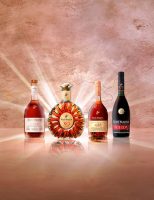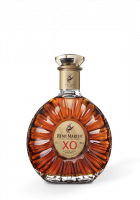INTRODUCTION
It all starts with the grape harvest, followed by distillation, eaux-de-vie selection and finally aging – which can take several decades. Learn more about each step of our craftsmanship and the unique role of our Cellar Master at the house of Rémy Martin.

The grapes growing on those crus are known to yield wines of exceptional quality and finesse
Founded in 1724, the House of Rémy Martin specializes in the creation of Cognac Fine Champagne, an “appellation d’origine contrôlée”, defining a blend of eaux-de-vie originating from the two central crus of the Cognac region: Grande Champagne (for a minimum of 50%) and Petite Champagne.
The grapes growing on those crus are known to yield wines of exceptional quality and finesse. Distillation on the lees and long ageing then reveal the full potential of the eaux-de-vie, creating the elegant and opulent aromatic signature of Rémy Martin cognacs.
appellation d’origine contrôlée
COGNAC FINE CHAMPAGNE – A COMBINATION OF 2 TERROIRS
THE GRAPE HARVEST
The harvest takes place once the heat has faded, at the end of the long summer months.


The grapes are gently pressed and the juice is left to ferment for five to seven days
The result is a white wine – dry, acidic, 7-9% alcohol content and no added sugar – perfect for distillation.
The House of Rémy Martin is built on quality, and to make sure we have access to the required amounts of the highest quality grapes every year, we formed the Alliance Fine Champagne.
Set up in 1966 and still in place today, this one-of-a-kind alliance with the winegrowers and distillers of Fine Champagne ensures strong long-term relations on the basis of an equal partnership. We work closely with the roughly one thousand winegrowers in the alliance, advising them on how to meet the Rémy Martin standard, making sure the expertise and craftsmanship honed over three centuries are passed on.
DISTILLATION PROCESS
After harvest, distillation takes place over a few months – from October to March.


“Our distillation methods remain traditional to this day”
We distill the wines with their lees – the residual yeast – in small copper stills to produce an intense spirit with more depth and aromatic intensity than modern large-scale methods would yield. This approach also helps maintain consistency in flavor. Each batch is distilled twice over, a process that takes approximately 24 hours. Lengthy but essential to get the purest essence of the grapes’ aromas, we have used double distillation since our founding in 1724.
During each distillation, the first and last results are discarded in order to capture only the clearest, most aromatic, and most balanced heart, which is a clear liquid with an alcohol component of around 70 percent called eau-de-vie (“water of life”).
Twelve kilos of grapes are required to produce a single liter of eau-de-vie.
At Rémy Martin, we remain committed to these time-consuming and demanding distillation methods because they are the only way to produce the elegant eaux-de-vie that will guarantee the Rémy Martin signature style, and that have the potential to age in our cellars for years or even decades.
EAUX-DE-VIE SELECTION
After distillation, it is time to select the eaux-de-vie that will be aged in our cellars.

“We ask the growers to present eaux-de-vie that are fruity, rich, elegant, and delicate.”
Each year, over 1,000 winegrowers submit their eaux-de-vie for selection. To our Cellar Master, each eau-de-vie has a unique personality, possessing slightly different flavors and aromas. The challenge is to preserve the essence of Cognac Fine Champagne and to carry forward the Rémy Martin signature style.
During the winter months, our tasting committee gathers several times a week to sample 20 to 30 eaux-de-vie per session. Over the course of the season, they will taste over 2,000 samples.
The samples are blind, their origin confidential. The committee looks for eaux-de-vie that are fruity and rich, while not being too heavy – in other words, they look for elegance and harmony.
Certain eaux-de-vie do not possess these qualities and are rejected immediately, while others distinguish themselves as suitable to convey the Rémy Martin signature style. After this rigorous selection process, the eaux-de-vie are stored in the cellars for aging before becoming part of the future cognacs of the House.
AGING COGNAC
Since eaux-de-vie of Grande Champagne and Petite Champagne have great ageing potential, we choose to age them for much longer than the minimum term (2 years) required by the Cognac specifications.


“The eaux-de-vie used to blend our cognacs are aged for many years.”
We use casks made from oak of the type found in the forests of Limousin, famous for the quality of its wood. Limousin oak contributes to the aromatic development of the blended eaux-de-vie by allowing a careful yet substantial exchange between the eaux-de-vie and the air inside the cellar. Thanks to its large and open grain, it imparts a rich vanilla flavor to the cognac.
The oak trees used are at least a hundred years old and have been individually selected by expert coopers working closely with our Cellar Master. Before being shaped into a cask, the wood is left outside for two to three years so the elements can remove the less interesting tannins.
Our cellars in Merpins store 140,000 casks of Cognac Fine Champagne eaux-de-vie, the largest collection in the world. All eaux-de-vie for our cognacs age for years, subtly adapting to their surroundings. Each cellar has a slightly different temperature and humidity, thus fine-tuning the aging environment. The type of cask also affects the process, so depending on the cognac it will be used for, an eau-de-vie may be changed to progressively older casks as it ages.
During the aging process, a percentage of the eaux-de-vie evaporates into the air. We call this “the angel’s share”. Approximately the equivalent of eight thousand bottles evaporates every day.

“Our Cellar Master guards the heritage of the House, whilst creating its future every single day.”
THE CELLAR MASTER
The Cellar Master has to possess a very special combination of skills: he is at once a studied viticulturist, an experienced winemaker, an expert blender, and a taster with a sensitive nose, with a little bit of the virtuoso composer and magician thrown in for good measure. The Cellar Master not only guards the heritage of the House but also, every day, creates its future – advising the winegrowers on grapes and distillation, sampling and selecting the best eaux-de-vie, and watching over their aging.

“Only when you’re sure that it’s the right person do you share your secrets.”
The Cellar Master has to possess a very special combination of skills: he is at once a studied viticulturist, an experienced winemaker, an expert blender, and a taster with a sensitive nose, with a little bit of the virtuoso composer and magician thrown in for good measure. The Cellar Master not only guards the heritage of the House but also, every day, creates its future — advising the winegrowers on grapes and distillation, sampling and selecting the best eaux-de-vie, and watching over their aging.
The Cellar Master is the only one who can recreate the blends for every product in our collection each year, making sure that even if the vintage and the aging vary, to the connoisseur there won’t be any difference between a bottle bought in 1987 and a bottle bought in 2017.
When Baptiste Loiseau was appointed Cellar Master in 2014, he was, at the age of 34, one of the youngest ever. He was also succeeding Pierrette Trichet, the first woman to ever hold this position at a major cognac house. So while the main responsibility of the Cellar Master is to guard the House’s heritage, at Rémy Martin we strive to be forward-thinking about whom we charge with this duty.

Each Cellar Master is taught directly by their predecessor, who protects the mysteries of blending for the next generation.
Baptiste Loiseau was born and raised in Cognac and started out as an experimental engineer before joining Rémy Martin’s tasting committee under Pierrette Trichet. He worked with her for four years, tasting, selecting, and blending eaux-de-vie with the former Cellar Master before she decided he could be her successor and appointed him her deputy in 2011.
That was when she finally opened the books to him and spent three more years teaching him all the blends. “Only when you’re sure that it’s the right person do you share your secrets,” Loiseau explains.
With Baptiste Loiseau, we began a new chapter in the story of our House, keeping the Rémy Martin legacy alive for the future.






























